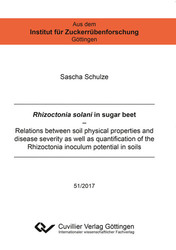| Departments | |
|---|---|
| Book Series (96) |
1378
|
| Nachhaltigkeit |
3
|
| Gesundheitswesen |
1
|
| Humanities |
2364
|
| Natural Sciences |
5406
|
| Mathematics | 229 |
| Informatics | 319 |
| Physics | 980 |
| Chemistry | 1363 |
| Geosciences | 131 |
| Human medicine | 243 |
| Stomatology | 10 |
| Veterinary medicine | 108 |
| Pharmacy | 147 |
| Biology | 835 |
| Biochemistry, molecular biology, gene technology | 121 |
| Biophysics | 25 |
| Domestic and nutritional science | 45 |
| Agricultural science | 1004 |
| Forest science | 201 |
| Horticultural science | 20 |
| Environmental research, ecology and landscape conservation | 148 |
| Engineering |
1793
|
| Common |
98
|
|
Leitlinien Unfallchirurgie
5. Auflage bestellen |
|
Advanced Search
Rhizoctonia solani in sugar beet (Volume 51) (English shop)
Relations between soil physical properties and disease severity as well as quantification of the Rhizoctonia inoculum potential in soils
Sascha Schulze (Author)Preview
Table of Contents, PDF (55 KB)
Extract, PDF (380 KB)
| ISBN-13 (Hard Copy) | 9783736995925 |
| ISBN-13 (eBook) | 9783736985926 |
| Final Book Format | A5 |
| Language | English |
| Page Number | 148 |
| Lamination of Cover | matt |
| Edition | 1. |
| Book Series | Aus dem Institut für Zuckerrübenforschung Göttingen |
| Volume | 51 |
| Publication Place | Göttingen |
| Place of Dissertation | Göttingen |
| Publication Date | 2017-07-31 |
| General Categorization | Dissertation |
| Departments |
Agricultural science
|
| Keywords | Rhizoctonia solani, AG2-2IIIB, soil structure, penetration resistance, agronomy, phytopathology, soil tillage, pathogen, soil inoculum potential, sugar beet, crown and root rot |








